Earlier this month we brought you a potted history of pop-culture’s obsession with the concept of tsunami surfing; spanning appearances in old Hawaiian folklore, through TV ads and Hollywood cult classics, to an alleged feature in one of youtube’s first viral videos.
Here, we’ll tell the story of what it’s actually like to be surfing when a tsunami hits.
***
The third day of Tom Gogola’s Samoan surf trip began much the same as the first two. He woke up at 5.45 am to the sound of Tim the surf guide knocking on the door of his beachside fale to let him know they were heading out to the reef before breakfast.
He jumped out of bed, did a quick stretch, waxed his board, said goodbye to his girlfriend Rachel and stepped out into the pre-dawn glow. Just seven steps and a row of towering palm trees, motionless that morning against the inky sky, separated his front door from the soft white sands of the lagoon.
He waded into the water and passed his board up to one of the eight passengers already on the boat as the bath-warm South Pacific sloshed against his knees. He was a long way from the estuarine waters of his home break in South Devon. As he climbed aboard, Tom remembers enquiring as to the whereabouts of a German and two Danish surfers who were staying at the camp. Apparently, they’d been up all night ill, possibly from the dinner, so wouldn’t be joining the early expedition.
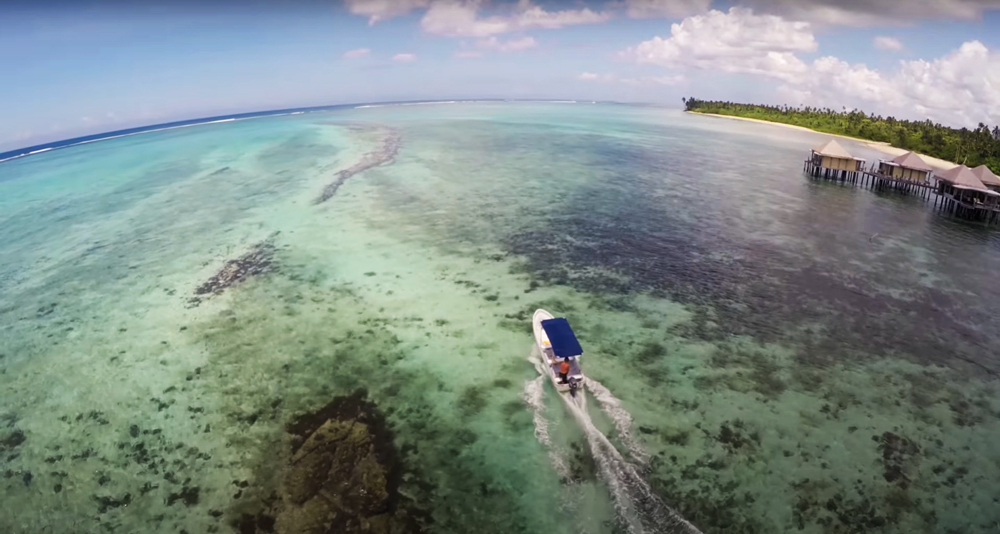
The boat set off west across the inner reef, headed for a fun left-hander named ‘Sales’, which breaks hard off the corner of a coral shelf before running into a deep channel carved by the river that flows off the land just a kilometre away.
After 15 minutes they arrived at the pass, dropping anchor just as the sun rose above the horizon. The surf was glassy, 4 foot, with the best ones running off for 100m or so. Tom was first off the boat.
“This is paradise,” he remembers thinking as he made his way to the peak. “Twenty-seven-degree water, good clean surf and not a care in the world.”
“I caught the first few waves of the day before the rest of the guys had paddled out and was stoked about surfing better than I was the day before,” he recounts.
After about an hour, another boat turned up and added a few more surfers to the lineup. Despite some terse words about moorings between the boat’s driver and Tim the surf guide, the vibes in the lineup were high.
At around 7am, with thoughts turning to heading back for breakfast, Tom noticed a rogue wave hit the reef.
“I was paddling back out at the time,” he says, “it jacked up in height and had this real square, unsurfable look about it. I remember looking at the coral and thinking, shit that was really shallow.”
As he reached the peak, he glanced back towards the inside. “The water was bubbling as if a 100 foot wave had just detonated. We were all really puzzled.”
“After that, the whole lineup started fizzing and surging violently,” he continues. “Then a guy from the other boat said casually, ‘I think the waves are done for the day, best get off the reef, think there’s a tsunami coming.’”
Tom remembers feeling more skeptical than panicked as he put his head down and followed the rest of the pack as they paddled off towards the channel.
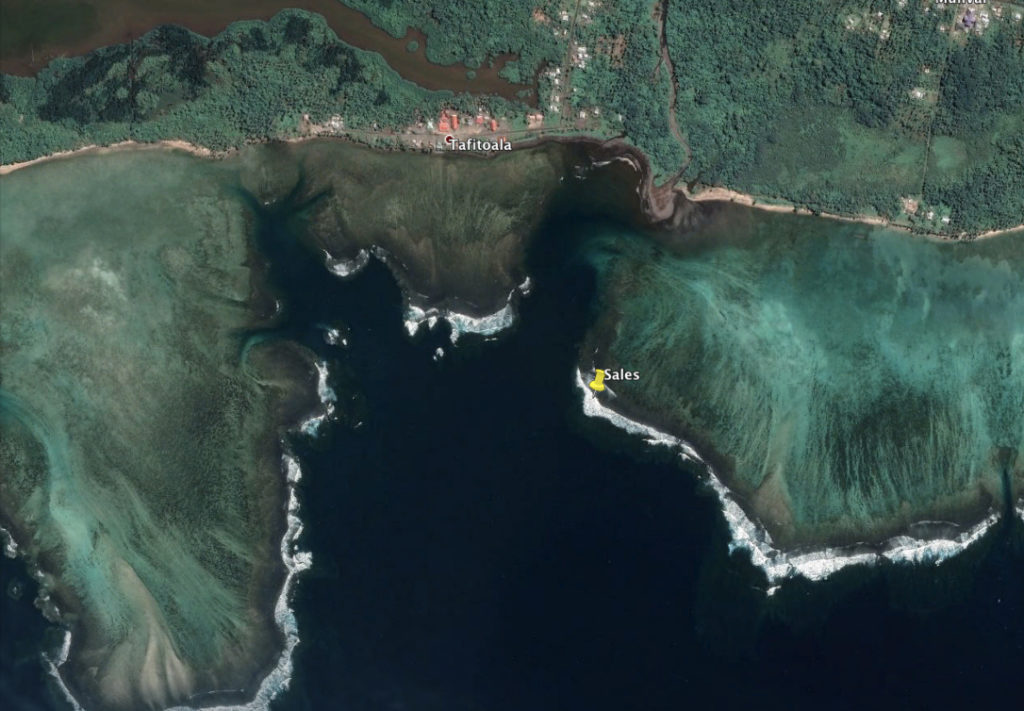
“By the time I got to the deeper water, there were only 3 guys left out the back,” he says.
Looking around, he was surprised to see some of his group already a distance away, paddling frantically back towards the land. “They were swimming like they’d just seen a shark,” he remembers. “We shouted for them to turn around and come back but they didn’t.”
Tom remembers contemplating whether or not a big tsunami was really on its way and briefly discussing with the others if they’d be better off paddling back to the boat. Just as they decided to stay put, the other boat in the channel roared to life and sped off out to sea.
Right then, the water level started to drop dramatically. “It was like someone had pulled the plug out of the ocean,” Tom remembers. “Within the space of a minute, the reefs that had been one metre deep were suddenly four meteres above sea level, with the millions of gallons of water rushing off them creating violent waterfalls all around us.”
“The guys that were paddling in were stuck in the middle of it, in a gap of only 20 metres or so between two reefs. It must have been extremely scary for them.”
Further out, he and the others spent the next hour and a half paddling in the deep water, trying to hold position against the currents as the ocean surged back and forth.
“We were waiting for one of two things,” he says matter of factly, “either for it to finish and level itself out, or for a big tsunami wave to kill us all like the one in Indonesia.”
“I came to terms with the idea that we were going to die and there was nothing we could do about it.”
“Thankfully the wave never came for us,” Tom continues. “Instead the surges carried on. One minute everything was calm and seemed normal then the next it was like Niagara falls unloading off the reefs, leaving turtles, sharks and flapping fish dry on the coral.”
After each surge, the water rushed back off the land, carrying logs, plastic drums and coconut trees, forming huge standing waves as it met the incoming swell.
In the distance, Tom could see their boat rocking violently in the vortex just a few meters from the edge of the reef. There was no sign of the other group.
For what felt like an age, the ocean continued to surge fiercely back and forth, as the four remaining surfers paddled helplessly out the back of the reefs.
Eventually, after about the fifth, or sixth surge, the swirling maelstrom of debris and swell finally began to settle and the group decided to leave the safety of the deep water and head back to the boat. After wrestling to free the anchor, which had become lodged deep into the coral, they set off, tracing the back of the reefs east towards the camp.
“It was only when we got in line with the village that we got a sense of the damage on land,” remembers Tom. “One of the first things we noticed was a pair of kayaks that had been snapped clean in half bobbing upright way out to sea. Then we saw the roof of the next door camp’s luxury restaurant float past.”
Although desperate to get back and find the other guests, including Tom’s girlfriend Rachel and another of the group’s wife and kids, they decided to search the deep water first, in case anyone snorkelling or kayaking had been washed out when the water receded.
“After an hour we couldn’t see anyone,” says Tom. “But we found everything from tables, chairs, lizards on timber, roofs, walls, drinks, eskys, surfboards, board bags, dive gear, and most unbelievably, the two butane gas tanks from the restaurant spinning, bubbling and hissing as the gas escaped.”
Suddenly, amid a dense patch of debris, the motor of the boat lost power and the group were forced to grab anything they could find to use as oars to fight against the rip dragging them towards the reef. As the water began to recede again, they feared another surge may be imminent.
After a bit of panicked tinkering, Tim got the motor working and they were able to safely navigate back out to deeper water, where they sat idling, scanning the horizon for signs of the next surge. They watched as the water level swelled and dipped, grateful that the intensity seemed to be fading with each cycle. After another hour or so, the group agreed it was safe to go ashore.
As they approached the beach through a narrow gap in the reef, the scale of the devastation came into focus.
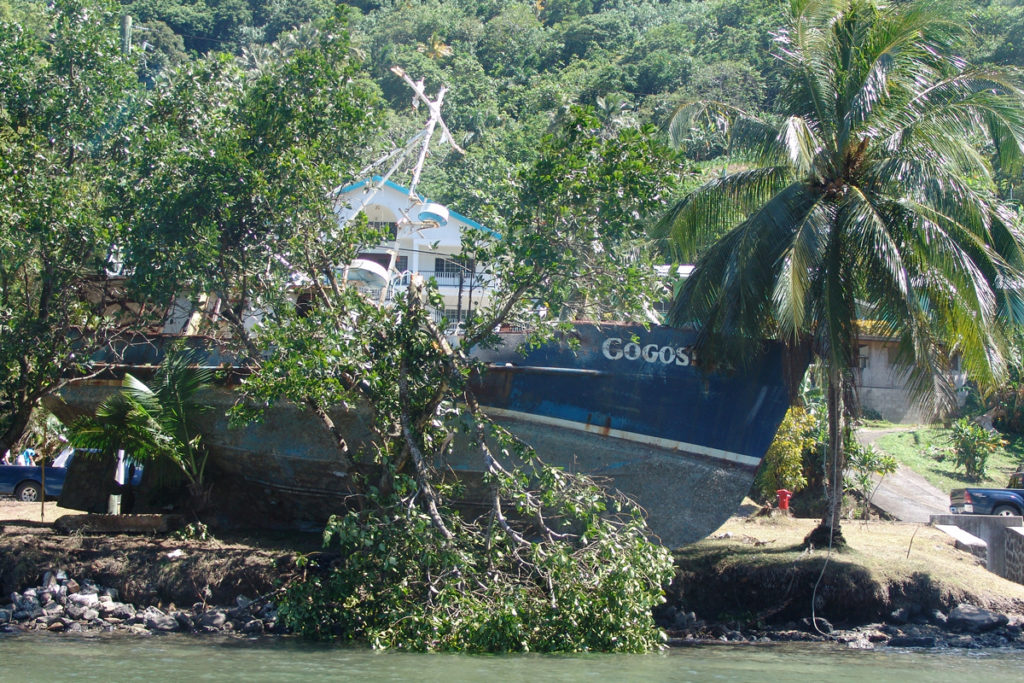
“There were no fales, restaurants, shops, bars or kitchens,” Tom remembers, “In fact the only things that were left standing were the coconut trees.”
“Bits of fale were spread 100 meters back from the sea and up into the bush.”
At the camp they found police, rescue workers and locals, but no sign of any of the guests who’d stayed behind. There was a rumour they’d got out, but no one seemed to have any concrete information. “It certainly wasn’t enough to be satisfied,” recalls Tom.
They were however happy to be reunited with all but one of the other surfers from their boat, last seen paddling off in the direction of the land before the first surge.
“They told stories of how they rode the 6 foot waves breaking on the shore up into the thick jungle and wrapped their arms around coconut trees,” says Tom. “They had to climb high into the canopy to stop from being sucked back out to sea.”
Desperate to get out of the village and up into the hills to search for their missing loved ones, some of the group tried frantically to start a hire car while others combed through the sprawling mass of rubble.
“I must have searched under roofs, bits of wooden walls and fallen coconut trees for a couple hours in the blistering heat,” Tom remembers, “not knowing if I would find Rach or anyone else under them.”
After the battle with the vehicle’s saturated electrics proved fruitless, the group were relieved to see a car come rattling down the road towards the village. Inside were an English couple who’d heard about the devastation and wanted to offer help. After they explained their situation, the couple offered them a lift back up the mountain. They piled in and set off.
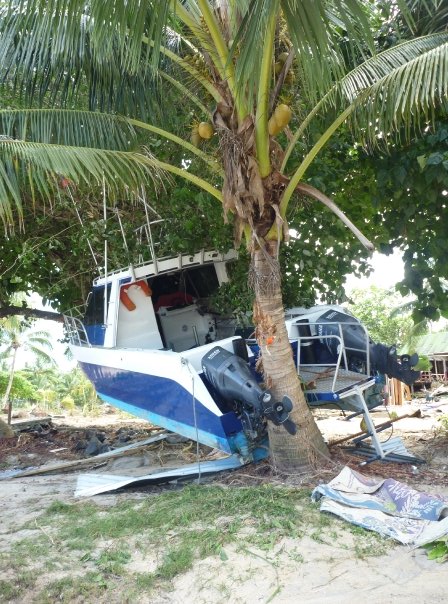
Ten minutes up a rough dirt road they came across a school and got out to ask those inside if they’d seen any of their lost party. With no luck, Tom was just about to climb back into the car when to his amazement he spotted the last remaining surfer from the morning’s boat trip, huddled in the corner of a field.
“I was so glad to see he was good,” he remembers. “I said: ‘Jump in the car well take you back to Maninoa, everyone thinks your dead!’”
“As we drove back down into the village I noticed a red Jeep that belonged to some of the Kiwi girls who had been staying next door,” Tom continues. “And there was Rache, with all the others from our camp.”
“I was overwhelmed with emotions of everything that had happened in the day. I went over to Rach who was sifting through the remains and gave her a big hug.” The sense of relief was extreme; a punctuation mark on a day packed with the full spectrum of human emotions.
“We stayed in Apia [the island’s capital city] for the next few days, while trying to pick up the pieces,” Tom says. “We tried to dry out belongings, talk to travel insurance, sort emergency passports and try to come to terms with all that just happened.”
It turned out Rachel and the rest of the group had escaped thanks to the warning offered by the quake. After the earth stopped shaking, they looked out and saw that the reefs had all drained off. After the widely publicised tsunami of 2004, the group recognised the warning signs. They roused everyone from their beds, jumped in the Jeep and fled to the hills.
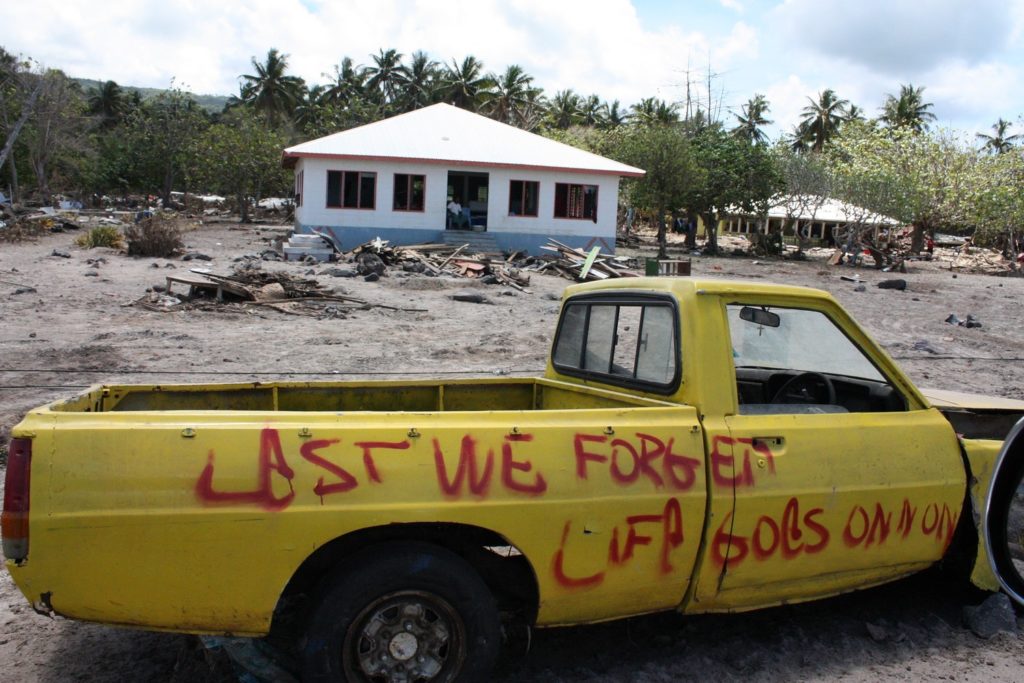
Sadly, in many coastal villages on the island, the residents hadn’t been so lucky. In total, twenty settlements were completely destroyed along Upulo’s south facing coastline. 149 people were confirmed dead and 3000 more left homeless. And further afield, in American Samoa and Tonga at least 43 more lost their lives.
In the aftermath, a group of scientists determined that the tsunami had been triggered by an extremely rare event known as ‘doublet’, where at least two separate earthquakes occur in the same area in quick succession. The tsunami’s highest waves measured 14 metres (46 ft) as they slammed into the Samoan coast.
Tom still thinks about how lucky he is to be alive. Saved by the calm assessment of a fellow surfer and a few favourable quirks of seabed topography. There’s no doubt had the conditions been different, and they’d opted for another reef pass, the outcome too could have been far graver. Instead, the group were allowed to walk away with nothing but a stark reminder of the size, scale and power of our ocean playground.
Cover photo: Waterways Travel

